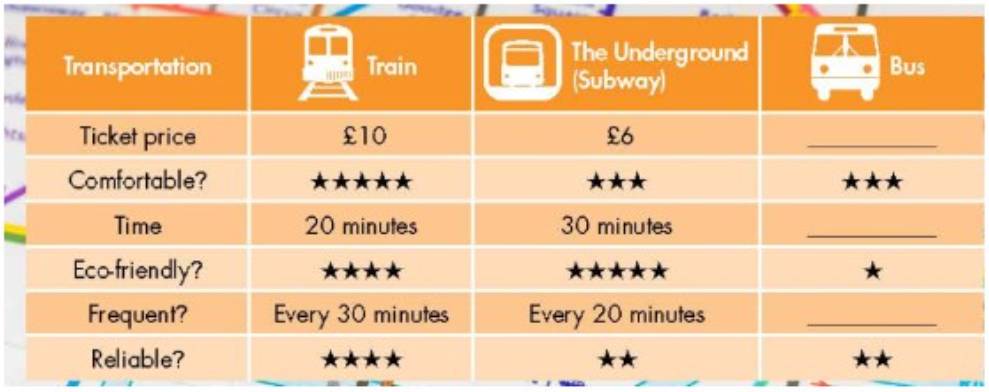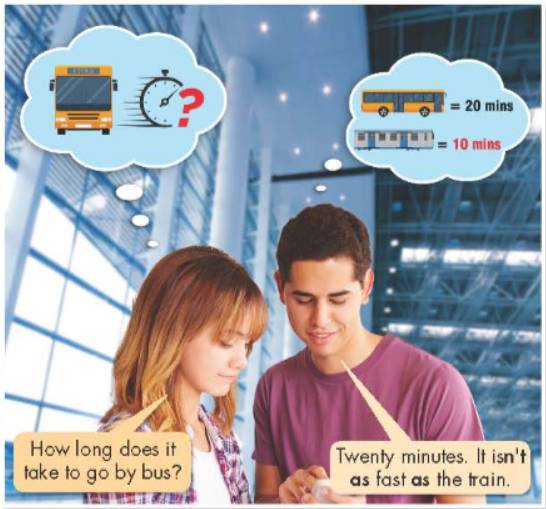Lesson 2
Các câu hỏi tương tự
c. Listen to the /st/ sound. Find and note down three more words with the same sound.(Nghe cách phát âm /st/. Tìm và ghi chú hơn 3 từ với âm tương tự.) faster (nhanh hơn)station (ga)best (tốt nhất)
Đọc tiếp
c. Listen to the /st/ sound. Find and note down three more words with the same sound.
(Nghe cách phát âm /st/. Tìm và ghi chú hơn 3 từ với âm tương tự.)
faster (nhanh hơn)
station (ga)
best (tốt nhất)
a. You are deciding how to get to Richmond Park. In pairs: Student B, 121 File 8. Student A, ask your partner about the bus and answer their questions about the train. Then, compare the different ways to travel and decide how you will get to the park.(Bạn đang quyết định đi đến công viên Richmond như thế nào. Theo cặp: Học sinh B, file 8 trang 121. Học sinh A, hỏi bạn đồng hành về xe buýt và trả lời câu hỏi về tàu hỏa. Sau đó, so sánh các cách khác nhau để đi du lịch và quyết định bạn sẽ đến côn...
Đọc tiếp
a. You are deciding how to get to Richmond Park. In pairs: Student B, 121 File 8. Student A, ask your partner about the bus and answer their questions about the train. Then, compare the different ways to travel and decide how you will get to the park.
(Bạn đang quyết định đi đến công viên Richmond như thế nào. Theo cặp: Học sinh B, file 8 trang 121. Học sinh A, hỏi bạn đồng hành về xe buýt và trả lời câu hỏi về tàu hỏa. Sau đó, so sánh các cách khác nhau để đi du lịch và quyết định bạn sẽ đến công viên như thế nào.)

A: How much is the bus?
(Giá xe buýt là bao nhiêu?)
B: The train is faster than the underground.
(Tàu hỏa thì nhanh hơn tàu ngầm.)
A: Yes, but the underground isn't as expensive as the train.
(Đúng, nhưng tàu ngầm không đắt như tàu hỏa.)
a. Practice the conversation. Swap roles and repeat.(Thực hành bài hội thoại. Hoán đổi vai trò và lặp lại.)Bill: We can take the train or the subway. (Chúng ta có thể đi tàu hỏa hoặc tàu điện ngầm.)Lucy: How much is the subway? (Giá tàu điện ngầm là bao nhiêu?)Bill: Its nine dollars. How much is the train?(9 USD. Vậy giá tàu hỏa là bao nhiêu?) Lucy: Its sixteen dollars. The subway isnt as expensive as the train.(16 USD. Tàu điện ngầm không đắt bằng tàu hỏa.)Bill: Yes, but the train has bigger ch...
Đọc tiếp
a. Practice the conversation. Swap roles and repeat.
(Thực hành bài hội thoại. Hoán đổi vai trò và lặp lại.)
Bill: We can take the train or the subway.
(Chúng ta có thể đi tàu hỏa hoặc tàu điện ngầm.)
Lucy: How much is the subway?
(Giá tàu điện ngầm là bao nhiêu?)
Bill: It's nine dollars. How much is the train?
(9 USD. Vậy giá tàu hỏa là bao nhiêu?)
Lucy: It's sixteen dollars. The subway isn't as expensive as the train.
(16 USD. Tàu điện ngầm không đắt bằng tàu hỏa.)
Bill: Yes, but the train has bigger chairs. It's more comfortable than the subway.
(Đúng vậy, nhưng tàu hỏa có ghế to hơn. Nó thoải mái hơn tàu điện ngầm.)
Lucy: Let's take the train.
(Vậy đi tàu hỏa nhé.)
Bill: OK
the bus/a taxi (xe buýt/ taxi) the bus/a taxi (xe buýt/ taxi) five dollars/thirty dollars (5 USD/ 30 USD) The bus - expensive/A taxi - cheap (xe buýt - đắt/ xe taxi - rẻ) more frequent - the bus/faster - a taxi (thông dụng hơn - xe buýt/ nhanh hơn - xe taxi) |
b. Now, read and fill in the blanks.(Bây giờ, đọc và điền vào chỗ trống.)1. The _________way to travel from Ho Chi Minh City to Hanoi is flying. 2. Some cities have_________ buses. 3. The trains are often not as__________ as the buses. 4. You can buy tickets for planes, buses, and trains_________.5. Taxis are a great way to get around a city_________.
Đọc tiếp
b. Now, read and fill in the blanks.
(Bây giờ, đọc và điền vào chỗ trống.)
1. The _________way to travel from Ho Chi Minh City to Hanoi is flying.
2. Some cities have_________ buses.
3. The trains are often not as__________ as the buses.
4. You can buy tickets for planes, buses, and trains_________.
5. Taxis are a great way to get around a city_________.
d. In pairs: Make more sentences about transportation from the table. Use the prompts.
(Theo cặp: Viết câu về phương tiện từ bảng sử dụng gợi ý.)
bus/ car/ travel time (xe buýt/ ô tô/ thời gian di chuyển) train/ taxi/ cost (tàu hỏa/ taxi/ chi phí) |
b. Join another pair. Will they use the same type of transportation? Why (not)?
(Tham gia vào một cặp khác. Họ sẽ sử dụng phương tiện giống nhau không? Tại sao (không)?)
a. Fill in the blanks. Listen and repeat.(Điền vào chỗ trống. Nghe và lặp lại.)
Đọc tiếp
a. Fill in the blanks. Listen and repeat.
(Điền vào chỗ trống. Nghe và lặp lại.)

a. Listen and repeat.(Nghe và lặp lại.) Girl: How long does it take to go by bus?(Đi xe buýt mất bao lâu?)Boy: Twenty minutes. It isnt as fast as the train.(20 phút. Nó không nhanh bằng tàu hỏa.)
Đọc tiếp
a. Listen and repeat.
(Nghe và lặp lại.)

Girl: How long does it take to go by bus?
(Đi xe buýt mất bao lâu?)
Boy: Twenty minutes. It isn't as fast as the train.
(20 phút. Nó không nhanh bằng tàu hỏa.)
b. Rewrite the sentences using (not) as...as...(Viết lại câu sử dụng cấu trúc (not) as...as...)1. My backpack is newer than yours. (old)(Ba lô của tôi mới hơn của bạn.)- My backpack isnt as old as yours.(Ba lô của tôi không cũ như của bạn.)2. My suitcase is the same size as yours. (big)(Va-li của tôi cùng cỡ với cái của bạn.)3. Your sunglasses are more expensive than mine. (expensive)(Kính râm của bạn đắt hơn của tôi.)4. Trains and buses are both comfortable. (comfortable)(Tàu và xe buýt đều tho...
Đọc tiếp
b. Rewrite the sentences using (not) as...as...
(Viết lại câu sử dụng cấu trúc (not) as...as...)
1. My backpack is newer than yours. (old)
(Ba lô của tôi mới hơn của bạn.)
-> My backpack isn't as old as yours.
(Ba lô của tôi không cũ như của bạn.)
2. My suitcase is the same size as yours. (big)
(Va-li của tôi cùng cỡ với cái của bạn.)
3. Your sunglasses are more expensive than mine. (expensive)
(Kính râm của bạn đắt hơn của tôi.)
4. Trains and buses are both comfortable. (comfortable)
(Tàu và xe buýt đều thoải mái.)
5. My ticket is more expensive than your ticket. (cheap)
(Vé của tôi đắt hơn vé của bạn.)
b. Practice with your own ideas.
(Luyện tập với ý tưởng của bạn.)


